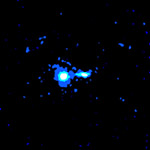PKS 0637-72 is so distant that we see it as it was 6 billion years ago. It is a luminous quasar that radiates with the power of 10 trillion suns from a region smaller than our solar system. The source of this prodigious energy is believed to be a supermassive black hole.
Radio observations of PKS 0637-752 show that it has an extended radio jet that stretches across several hundred thousand light years. Chandra's X-ray image made with the Advanced CCD Imaging Spectrometer (ACIS) reveals a powerful X-ray jet of similar size that is probably due to a beam of extremely high-energy particles.
Quasars
Quasars are distant, energetic objects. They are compact intense
sources of X-rays as well as visible light, and can be brighter
than hundreds of galaxies put together.
Through an optical telescope quasars look star-like. It wasn't until the 1950's, when radio astronomy was first developed, that astronomers realized these were extra-galactic objects that were emitting enormous amounts of radio energy. This important discovery caused them to be named quasars, short for "Quasi-stellar radio sources". Since then, many quasars have been discovered that produce little or no radio emission. They are sometimes called quasi-stellar objects or QSO's, but the name quasars is generally used to describe both types of objects.
The power of a quasar depends on the mass of its central black hole and the rate at which it swallows or accretes matter. Almost all galaxies, including our own, are thought to contain a supermassive black hole in their centers. Quasars represent the extreme cases where the rate of accretion is so high that the energy output due to the infalling matter is a thousand times greater than the galaxy itself.
One of the most intriguing features of supermassive black holes is that they do not suck up all the matter that falls within their sphere of influence. Most of the matter falls inexorably toward the black hole, but some explodes away from the black hole in high-energy jets that move at near the speed of light. Radio observations have revealed that these jets are a common feature of quasars.
NASA's Chandra X-ray Observatory Reveals a
Powerful X-ray Jet in PKS 0637-752
The X-ray jet observed for the first time by Chandra in PKS
0637-752, is a dramatic example of a cosmic jet. It has blasted
outward from the quasar into intergalactic space for a distance
of at least 200,000 light years! The jet's presence means that
electromagnetic forces are continually accelerating electrons to
extremely high energies over enormous distances. Chandra
observations, combined with radio observations, should provide
insight into this important cosmic energy conversion
process.



